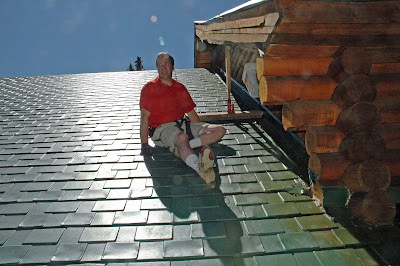On Midsummer's Eve, June 20, 2011 we hiked six miles over snow to check out Camp Loll. This is a shot of the Parade Ground that day. One can see the piece of the roof broken off and lying on the snow, also the way the edge of the roof of the "over lap" between the two halves of the building has broken.

I knew this wasn't good, and we worried all summer about how to fix the damage. As Camp came to a close for the summer, and nothing had been done, I began to worry that another winter would come and bring a real disaster.

In this picture, taken last July, one can see how the roof has buckled. Underneath the I shaped truss has broken and the plywood also cracked. The permanent fix will require the sheeting to be removed, a new and stronger truss installed and new plywood sheeting, tar paper, and steel installed.
It would not be possible with our time and resources to affect the total repair, but Lynn was determined to make it ready for winter. I must admit I was skeptical, but I had no idea what the Hinrichs boys could do with a jack. Over the next day I would begin to understand.

Lynn's view of the damage. I like the sun burst.

First, Lynn lifted the broken section back into place with a bottle jack.

A cool cat on a hot tin roof.

Down below Francisco Martinez cut the boards for the "knee braces" that Lynn would install. Scott would trim them to exact specifications and hand them up to his brother.

Up above, Lynn would measure and fit and nail into place.

The two brothers at work.

Braces in place. This job, which, quite frankly, I thought would not be do-able was finished before most of our crew even got into camp.










5 comments:
We don't know if the knee braces will hold. We'll find out next spring. A full repair is going to require some specialized skills and equipment—perhaps even heavy-duty equipment.
I'm not sure how much most folks appreciate the pictures showing the snow built up on the north side of the roof. That is heavily compacted stuff that has slid down and piled up. It builds up on the lower reaches of the roof because there is nowhere else for it to go.
The south face of the roof sheds all of its snow weight because the roof is so far above the ground on that side. Moreover, it sheds the snow faster because it gets more sunlight.
The result is that tremendous pressure is applied to the north side of the building for long periods of time without any opposing force being applied to the south side. This is causing the whole building to skew to the south. It is causing damage each season.
This is a battle against nature that will have to be fought as long as the structure has its current roof design.
So much useful data for everyone!
You should have worn a hat or a helmet. It looks like it was quite hot. Anyway, tin (or metal) roofs are one of my favorites. I can coat with paint any way I want it to. Also, it's durable in terms of lifespan and resistance against chemical reactions.
With how you were seated in the roof, it's as if you just climbed there to have fun. Haha! You looked so comfortable and you didn't even care if it's very hot up there. Well, with the help of your crew, I’m sure you didn't find it hard to finish the work quickly.
Really great post, thanks for sharing
Post a Comment